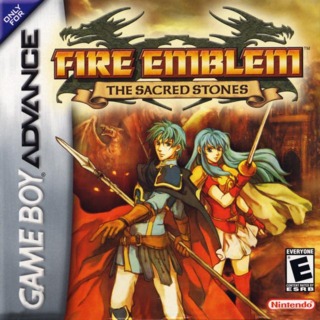If it ain't broken, don't fix it. A saying that Fire Emblem takes to heart, and follows.
For those who have not played, or even been aware of this series, Fire Emblem is a SRPG on similar grounds to chess. The game is split into several chapters (20+ specifically) in which you the player get to control a certain amount of units to fight in a fantasy world. These units are all viewed on a variety of battlefields from castles to forests, though they all have something in common, a grid. The units move around on set amount of squares which show up on the battlefield when it's their turn. How far they can move towards the enemy positions depends on their unit type. A Paladin on a horse for instance can move further accross plains then an axe wielding barbarian, yet gets bogged down by forests.
Each individual square on the grid also effects your units defense when they are standing on them depending on what geography it is. Having a unit stand on a mountain or forest will increase their defense, while plains and other types have no effect, making even standing still have a strategic element to it.
The characters in this game are all quite different in ability, ranging from Knights, swordsman, archers, priests, mages etc. All of which can be promoted to a new class upon reaching level 10, giving them new access to better weapons as well as a stat boost. Gaining experience for those levels happens every time a character performs an action. The bigger the action taken, the more exp gained, so killing an enemy would get more then healing an ally, however both are as important to succeed. So using a balanced party is vital.
Protecting your party is even more vital. This is because the Fire Emblem series has a unique feature among this genre. When one of your units dies in battle, they die for good. No Phoenix down feather tickle revivals, no miracle smelling salts that heal gaping chest wounds. They are lost to you forever. And as you have a set amount of characters to gain throughout the game, sacrifice is not an option.
To keep these units alive, having a good understanding of the battle system is the key. Ever played rock, paper, scissors? yes? good. Because that is what the attack sequnces are like in Fire Emblem. Only replace them with swords, axes, spears. All are very weak against one, and very strong against another. So knowing your unit types and their strengths and weaknesses is the difference between joyful long life, and swift frustrating death.
Visually you may be getting a sense of deja vu when playing Sacred Stones. Felt like you've seen it before? This may be because you have played the first Fire Emblem on the gba. All the sprites from that game have been recycled, meaning the game looks identical, character art aside. Not that that's all bad as it does look good, just not exciting if you have seen it all before.
As similar as it looks however, Sacred Stones has some interesting new features which make the game alot more fun and accessible then it's earlier counterpart. Firstly there is a world map to travel on between chapters. It may not sound exciting, but being able to go back to towns and buy equipment rather then during battle makes for organising your army alot easier, and less worrysome for future fights, as equipment only has a certain amount of durability.
Secondly, there are now random encounters on the world map with monster party's giving you a chance to level up, or use those characters you neglected rather then your main force.
The game lasts for about 20 hours or so, depending on how many added battles you participated in. With the chance to gain characters you may have missed or lost through unforseen death, replaying it is certainly an option, though there are little other benefits from following such a course.

